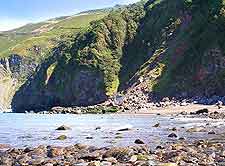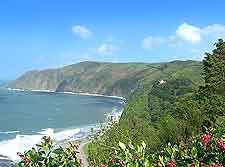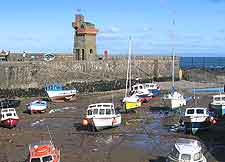Lynton and Lynmouth History Facts and Timeline
(Lynton and Lynmouth, North Devon, England)

Lynton and Lynmouth are best known as popular holiday towns on the North Devon coast. The two towns are inextricably linked throughout history, from the earliest times to the present day.
Whilst the origin of the towns' names is uncertain, it's thought that they related to either a Celtic pool or lime, a material that was once widely used in the area.
Early Origins
In 1086, Lynton and Lynmouth comprised of a population of just 425 people. They were relatively small, isolated communities, and that's how they stayed until the end of the 18th century.
The towns' growth from that time was the result of circumstance. Hundreds of miles away, war had broken out - the Napoleonic Wars. The hostilities meant that continental holidays were no longer available to wealthy English holiday makers. Instead, they had to search for alternative destinations that were closer to home. Lynton and Lynmouth were among the English beauty spots chosen. Early visitors included the likes of Shelley, Wordsworth and Coleridge.

Victorian Seaside Resorts
By the 19th century, tourism had developed for other reasons. The Lynton to Barnstaple railway arrived in 1898, opening the towns up to visitors who now found that they had more leisure time on their hands. Then history saw the arrival of the motor car, and it wasn't long before houses and hotels sprang up to keep up with growing demand.
Lynton and Lynmouth also attracted many wealthy businessmen. Thomas Coutts the banker was one such man. Another was Sir George Newnes, the publisher of the Sherlock Holmes story. His fortune helped to build the Town Hall and the Congregational Church. Newnes was also instrumental in building the Cliff Railway, which was officially opened in 1890. Operating on a water balance principle, it is one of the longest of its kind in Britain. The twin towns also have literary connections. The author Richard Doddridge Blackmore used Lynmouth as his base when he wrote the classic novel, 'Lorna Doone'.

In 1889, plans to install electric lighting in Lynmouth were hatched by Charles Geen. He believed that lighting up the town would give it the edge over other resorts in the area. By 1890, a hydroelectric power station had been built, making the town one of the first in Britain to provide electric street lighting.
The 20th Century History
In August 1952, Lynmouth suffered a terrible flood. Recognised as one of Britain's worst river flood disasters, it killed 34 people and destroyed over 90 buildings. Some 90 million tonnes of water flooded the community and the surrounding area, and in the harbour, every single boat was swept away. The power station also failed during the flood - it was to never work again. It took four years to rebuild the town and, to ensure this didn't happen again, the East Lyn and West Lyn rivers were widened still further.
Today, Lynton and Lynmouth still have relatively small populations. In the winter time, these amount to just a couple of thousand in total. Each summer, however, an influx of visitors transforms these twin towns.
 Lynton and Lynmouth are best known as popular holiday towns on the North Devon coast. The two towns are inextricably linked throughout history, from the earliest times to the present day.
Lynton and Lynmouth are best known as popular holiday towns on the North Devon coast. The two towns are inextricably linked throughout history, from the earliest times to the present day.
 In 1889, plans to install electric lighting in Lynmouth were hatched by Charles Geen. He believed that lighting up the town would give it the edge over other resorts in the area. By 1890, a hydroelectric power station had been built, making the town one of the first in Britain to provide electric street lighting.
In 1889, plans to install electric lighting in Lynmouth were hatched by Charles Geen. He believed that lighting up the town would give it the edge over other resorts in the area. By 1890, a hydroelectric power station had been built, making the town one of the first in Britain to provide electric street lighting.